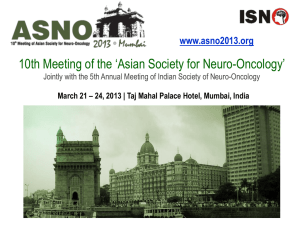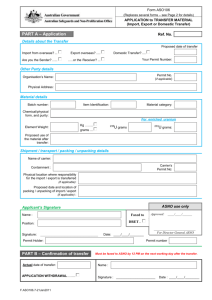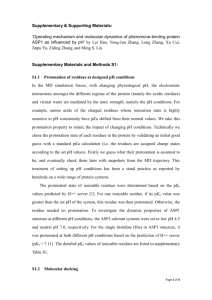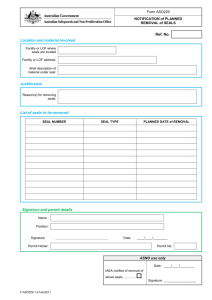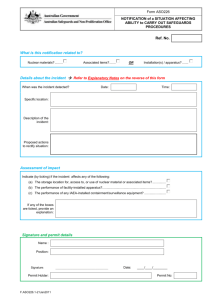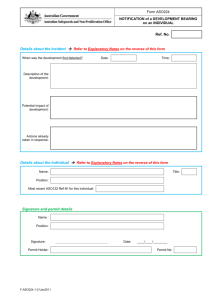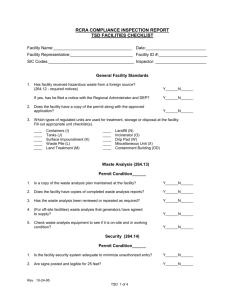DOCX 30 KB
advertisement
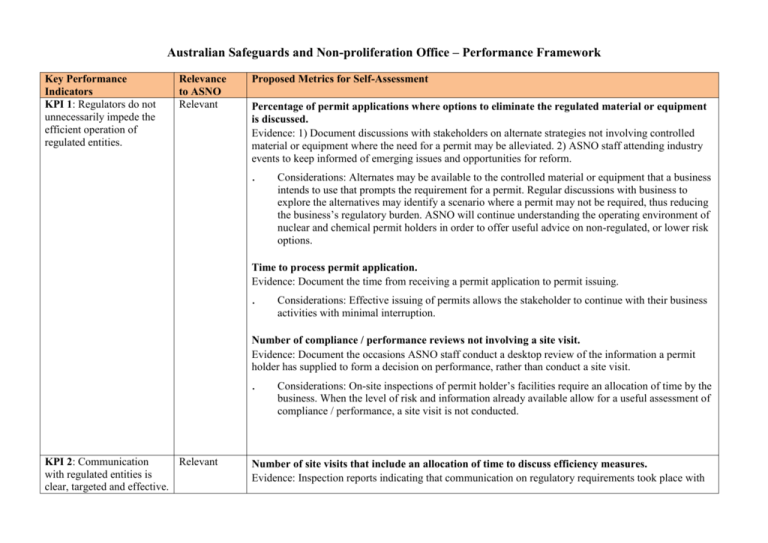
Australian Safeguards and Non-proliferation Office – Performance Framework Key Performance Indicators KPI 1: Regulators do not unnecessarily impede the efficient operation of regulated entities. Relevance to ASNO Relevant Proposed Metrics for Self-Assessment Percentage of permit applications where options to eliminate the regulated material or equipment is discussed. Evidence: 1) Document discussions with stakeholders on alternate strategies not involving controlled material or equipment where the need for a permit may be alleviated. 2) ASNO staff attending industry events to keep informed of emerging issues and opportunities for reform. Considerations: Alternates may be available to the controlled material or equipment that a business intends to use that prompts the requirement for a permit. Regular discussions with business to explore the alternatives may identify a scenario where a permit may not be required, thus reducing the business’s regulatory burden. ASNO will continue understanding the operating environment of nuclear and chemical permit holders in order to offer useful advice on non-regulated, or lower risk options. Time to process permit application. Evidence: Document the time from receiving a permit application to permit issuing. Considerations: Effective issuing of permits allows the stakeholder to continue with their business activities with minimal interruption. Number of compliance / performance reviews not involving a site visit. Evidence: Document the occasions ASNO staff conduct a desktop review of the information a permit holder has supplied to form a decision on performance, rather than conduct a site visit. KPI 2: Communication Relevant with regulated entities is clear, targeted and effective. Considerations: On-site inspections of permit holder’s facilities require an allocation of time by the business. When the level of risk and information already available allow for a useful assessment of compliance / performance, a site visit is not conducted. Number of site visits that include an allocation of time to discuss efficiency measures. Evidence: Inspection reports indicating that communication on regulatory requirements took place with the permit holder during a site visit. KPI 3: Actions undertaken by regulators are proportionate to the regulatory risk being managed. Relevant Considerations: On-site visits represent an excellent opportunity to discuss current and emerging regulatory requirements directly with a business. Context to their specific working environment can be added and questions answered directly and immediately. The business can then absorb the guidance into their processes. Establish risk-based inspection program. Evidence: Acknowledge whether a document describing the ASNO risk-based inspection program has been developed and implementation plan established. Considerations: Applying risk management policies and procedures to ASNO’s inspection program will ensure inspections will only occur when justified by a risk assessment using all available information on the business’s activities. External review of ASNO’s risk-based inspection program. Evidence: Document the dates that an entity external to ASNO has reviewed, and provided feedback on, the ASNO risk-based inspection program. Considerations: A work group external to ASNO will periodically be invited to review the ASNO risk-based inspection program to ensure that the program is appropriately structured to fulfil important (stated) objectives including minimising potential impact to businesses holding permits. Feedback gained from the review exercise will be considered by ASNO and contribute to our continuous improvement processes. KPI 4: Compliance and monitoring approaches are streamlined and coordinated. Relevant Establish streamlined inspection processes. Evidence: Note actions taken to implement procedures that lead to a streamlined inspection process that reduces the impact on permit holders. Considerations: ASNO business processes drive regular and ongoing review of the plans and arrangements used by the inspection team to facilitate permit holder monitoring and inspections. The effective streamlining of ASNO inspection protocols will result in more efficient engagement with businesses. External review of inspection method. Evidence: Document the dates that an entity external to ASNO has reviewed and provided feedback on the ASNO inspection procedures. KPI 5: Regulators are open and transparent in their dealings with regulated entities. Relevant Considerations: With the goal of improved efficiency in mind, a work group external to ASNO will periodically be invited to review the method employed by ASNO to conduct inspections. Quality of regulatory information provided on ASNO website and in the ASNO Annual Report. Evidence: Document the dates that regulatory-related guidance documents on the ASNO website are reviewed. Consideration: Up-to-date and accessible guidance documents on the ASNO website allow businesses to quickly access the advice required to assist them progress with compliance activities. Establish a feedback function on ASNO website that allows stakeholders to deliver feedback on usefulness of website and suggest improvements. Outreach activities conducted to communicate regulatory requirements to stakeholders. Evidence: Document the events and dates that outreach activities are conducted that provide information to stakeholders on regulatory requirements. Consideration: ASNO will take advantage of existing events within the relevant business community to directly communicate with businesses about nuclear and chemical regulatory requirements and strategies for implementing good practice. KPI 6: Regulators actively contribute to the continuous improvement of regulatory frameworks. Relevant Number of meetings attended to influence international policy. Evidence: Document the dates and describe activities where ASNO staff have participated in activities that influence international policy to benefit Australia stakeholders. Consideration: ASNO will continue to actively engage relevant international organisation such as the Office for the Prohibition of Chemical Weapons, the International Atomic Energy Agency and Comprehensive Nuclear-Test-Ban Treaty Organization to shape policies and standards that ensure, when implemented within Australia, that the frameworks support businesses. Engagement with other regulators to explore opportunities for regulatory efficiencies. Evidence: Document meetings and other joint activities with other Commonwealth and State regulators involving evaluation of regulatory frameworks. Consideration: Identify other national and state organisations that engage in nuclear and chemical regulation. Share experiences with these stakeholders including discussion on efficiency strategies.
